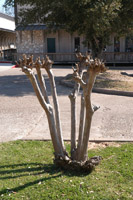It is almost spring in Texas, and the gardeners are getting busy! A few weeks ago, I shared information about pruning to help train plants, remove dead or diseased branches, and improve the quality of flowers and foliage. As I drive around Williamson County, I have noticed that the crape myrtles in some landscapes are pruned a little too much. In fact, we call this kind of pruning Crape Murder!
Crape myrtles are a beautiful flowering plant that can be grown as a shrub or shaped into a tree. Crape myrtles are low maintenance and add color to the landscape in the summer with beautiful blooms, in the fall with colorful foliage, and in the winter with interesting bark. Unfortunately, many homeowners and landscapers have a terrible habit of severely pruning or “topping” crape myrtles. This type of pruning is not necessary for crape myrtles to bloom. Topping crape myrtles delays their blooms, creates weak limbs where the new growth comes out, and makes ugly knobby scars where the prune cut was made.
There are a few times when pruning a crape myrtle is appropriate. You can prune the suckers that grow from the base to help shape the crape myrtle. Prune the suckers at ground level. You can also prune if branches are crossed and rubbing or are touching a structure or roof. Those are the only situations when it is necessary to prune a crape myrtle.
Sometimes, crape myrtles are topped to limit the growth because they get too tall. Stop it! Crape myrtles come in a variety of sizes from three feet tall to 35 feet tall. If your crape myrtle is too tall for your lawn, remove it and plant a new one that will grow to the appropriate size.
Please stop the crape murder this year! Texas A&M AgriLife Extension has a great FAQ and video about how to prune a crape myrtle. You can check it out on our Facebook page by searching for Williamson County Agriculture – Texas A&M AgriLife Extension. For more information about caring for crape myrtles, contact Kate Whitney, Williamson County Horticulture Extension Agent, at 512-943-3300 or klwhitney@ag.tamu.edu.


